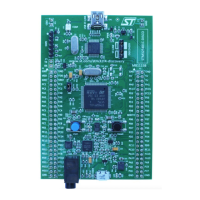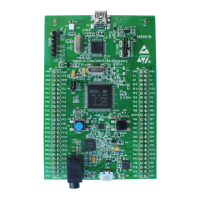RM0402 Rev 6 969/1163
RM0402 USB on-the-go full-speed (OTG_FS)
1122
29.2.2 Host-mode features
The OTG_FS interface main features and requirements in host-mode are the following:
• External charge pump for V
BUS
voltage generation.
• Up to 12 host channels (pipes): each channel is dynamically reconfigurable to allocate
any type of USB transfer.
• Built-in hardware scheduler holding:
– Up to 12 interrupt plus isochronous transfer requests in the periodic hardware
queue
– Up to 12 control plus bulk transfer requests in the non-periodic hardware queue
• Management of a shared Rx FIFO, a periodic Tx FIFO and a nonperiodic Tx FIFO for
efficient usage of the USB data RAM.
29.2.3 Peripheral-mode features
The OTG_FS interface main features in peripheral-mode are the following:
• 1 bidirectional control endpoint0
• 5 IN endpoints (EPs) configurable to support bulk, interrupt or isochronous transfers
• 5 OUT endpoints configurable to support bulk, interrupt or isochronous transfers
• Management of a shared Rx FIFO and a Tx-OUT FIFO for efficient usage of the USB
data RAM
• Management of up to 6 dedicated Tx-IN FIFOs (one for each active IN EP) to put less
load on the application
• Support for the soft disconnect feature.
29.2.4 Split rail for USB
In some package options it is possible to work with a split rail V
DDUSB
which has a more
restrictive voltage specification than the V
DD
which can work at a lower range.
When this is the case, and assuming that V
DD
is indeed below the minimum functional level
for V
DDUSB
, please take the following precautions.
For host only applications:
• No special precautions are necessary.
For VBUS powered USB2.0 peripheral device:
• No special precautions are necessary. V
BUS
detection is not needed, as V
BUS
state is
reflected directly in the presence of power supplies on the MCU.
All other cases (V
BUS
detection is required):
• Refer to the datasheet (Electrical Characteristics, and Appendix for application block
diagrams). A different range of the V
DD
supply will apply this case.

